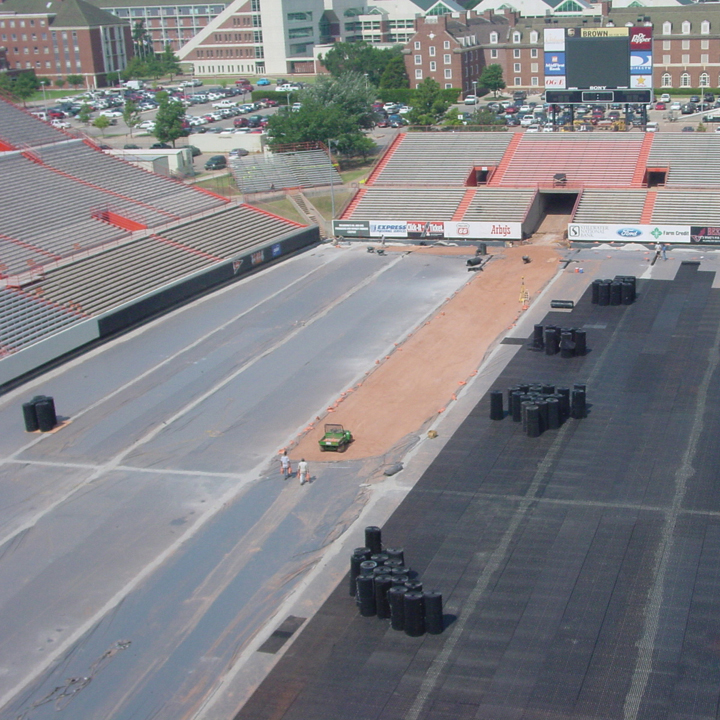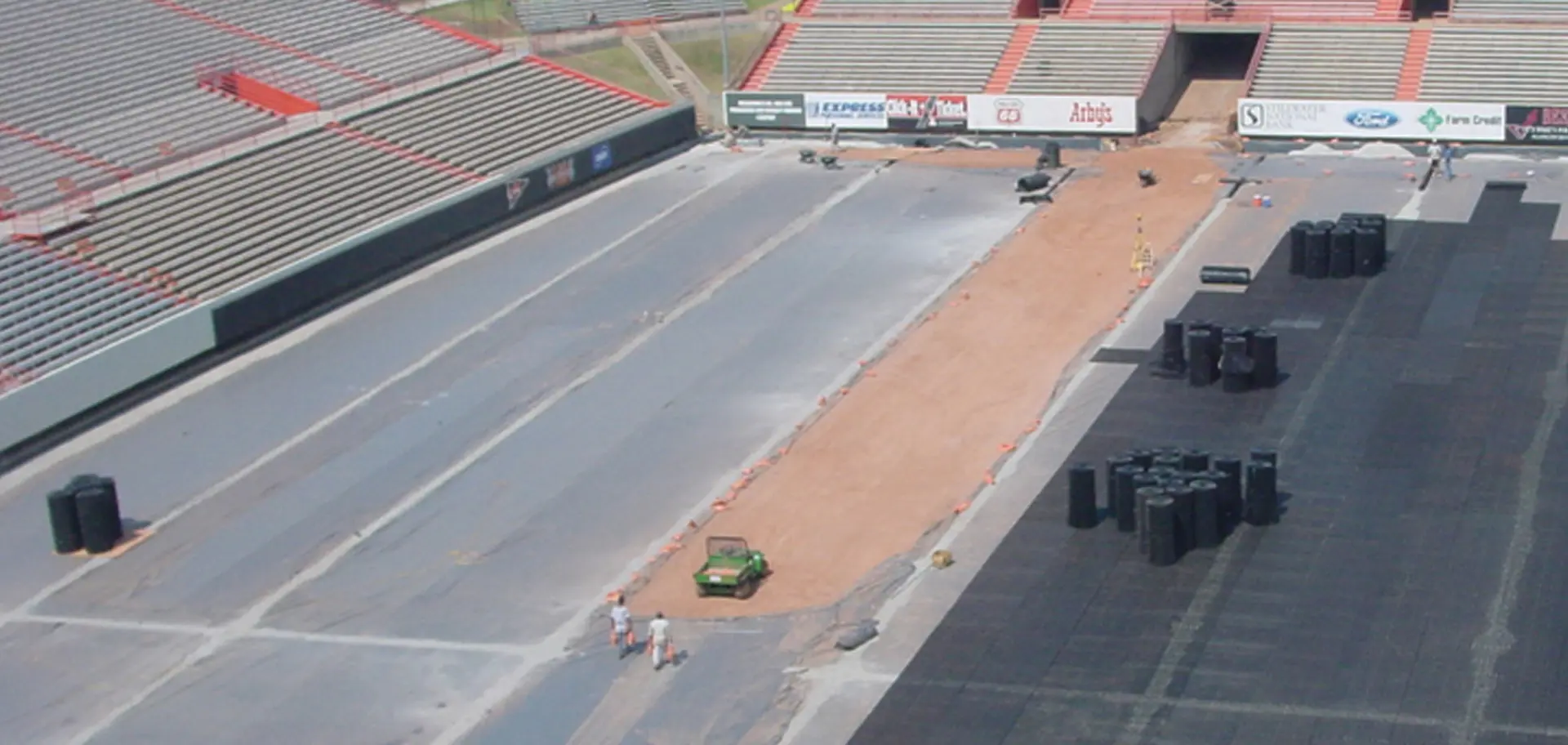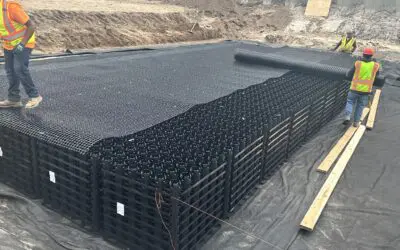Commercial & Residential Solutions
Stormwater Management
Helping You Weather the Storm
Specifically designed to address Stormwater Management issues, all Invisible Structures products are the best at draining or capturing water whether they are used together or separately. Drain water from the surface quickly with Grasspave2, Gravelpave2 and Draincore2. Store and reuse water underground with Rainstore3 and control erosion with. Slopetame3. Stormwater will be naturally filtered and sediments removed when passed through Grasspave2 or Gravelpave2 on its way to a Rainstore3 chamber.

Stormwater Management Frequently Asked Questions
Stormwater management is anything designed to mitigate the adverse effects of stormwater such as flooding, mud, rutting, pooling and general lack of drainage. All Invisible Structures products are designed to address these issues.
Underground detention systems include any structure or vessel designed to store rainwater or other liquid beneath the surface of the ground. A primary function of the vessel is stormwater management. Rainwater can be captured and fed back into the Earth to replenish groundwater or collected and harvested for future use. Storing water underground provides additional security as well. Examples of underground detention system include arched chambers and plastic modular systems such as Rainstore3.
Rainwater Collection Systems include any vessel, tank or other basin that is designed to collect and store excess rainwater. Examples of these are barrels, concrete storage tanks, arched chambers, detention basins and plastic modular systems – such as Rainstore3. Reasons to collect excess stormwater vary from flood prevention to harvesting for the purpose of reuse. The efficacy of these systems differ based on size and design.
Rain barrels and concrete storage tanks are limited in their capacity because of their impervious walls, whereas arched chambers, detention basins, and plastic modular systems have unlimited capacity. Arched chambers and plastic modular systems have the advantage of storing water underground, allowing for usable space such as parking lots or green spaces on top.
Only Rainstore3 is strong enough to support the weight of structures such as a parking garage or small building.
Rainwater Collection Systems are used for either water detention or water harvesting. Either method is an effective way to control stormwater for flood prevention. For reuse, water harvesting is required from an impervious vessel or storage basin. Harvested water can be used as gray water, for agricultural purposes or can be purified and used as potable water.
Water detention basins allow water to seep back into the ground recharging the ground water. The depletion of ground water has become one of the biggest environmental concerns our planet is facing.
All collection systems require some minimal maintenance in order to maintain optimal functionality.
There are several different types of Rainwater Collection systems. These include rain barrels, concrete storage tanks, arch chambers, milkcrate systems, and other plastic modular systems – such as Rainstore3. These different systems vary in size, cost, ease of installation and water storage/void capacity.
Rain barrels are the least expensive and do not require professional installation. Their capacity is limited by the size of the barrel. Concrete storage tanks are moderate in cost, also limited by their tank size, and require professional installation.
Arch chambers require a sizable installation area and a considerable amount of gravel fill which can be expensive. The void space is 40 – 50%. Milkcrate systems are mid-range in price but require complex assembly, which can add to the cost of labor. Their capacity is unlimited.
Modular plastic storage systems tend to be the highest initial cost but installation is relatively simple. Their capacity is also unlimited. Another benefit to plastic modular systems is the high void capacity and strength – Rainstore3 exceeds H-20 loading.
The amount of rainwater which can be collected varies by the type and size of the collection system used. Rain barrels typically hold 50 – 55 gallons per barrel. A rainfall of ½” on a 1,000 sq. ft. roof will fill one barrel. Concrete and plastic storage tanks range in size from 250 gallons to 15,000 gallons.
Arch chambers, milkcrate and plastic modular systems are only limited by the length, width and depth of the area as well as the void space of the system. For example, arch chambers provide only 40 – 50% space for water whereas Rainstore3 provides 96%.
There are several reasons to use a rainwater collection system. In areas with heavy rainfall where drainage is an issue, these systems can help mitigate the problems caused by flooding. All climates, including arid, can benefit by capturing rainfall and harvesting the water for reuse. Reusing water can save money and provide environmental benefits.
Another advantage of underground rainwater collection systems, not designed for harvesting, can replenish the groundwater. Water shortages and the decrease in our ground water are among the planet’s biggest environmental concerns today.
Related Project Profiles
Arizona Cardinal Football Stadium
Boone Pickens Stadium – OSU
Plaza Las Fuentas
Santa Fe Opera House
Related Blogs
The Impact of Freeze-Thaw Cycles on Paving Systems
Paving systems play a crucial role in modern infrastructure, providing stability and functionality to various surfaces. However, these systems are often subjected to environmental challenges, and one of the most significant threats is the freeze-thaw cycle. In regions...
Unveiling the Transformative Power of Permeable Pavers
Stormwater runoff poses a significant environmental challenge, causing pollution and flooding in urban areas. Traditional impermeable surfaces, such as asphalt and concrete, contribute to this issue by preventing water from infiltrating the ground. However, an...
The Benefits of Underground Water Storage
Water is a precious resource that plays a crucial role in sustaining life on Earth. As populations grow and climate patterns shift, the need for efficient water management becomes increasingly important. One innovative solution gaining popularity is underground water...













